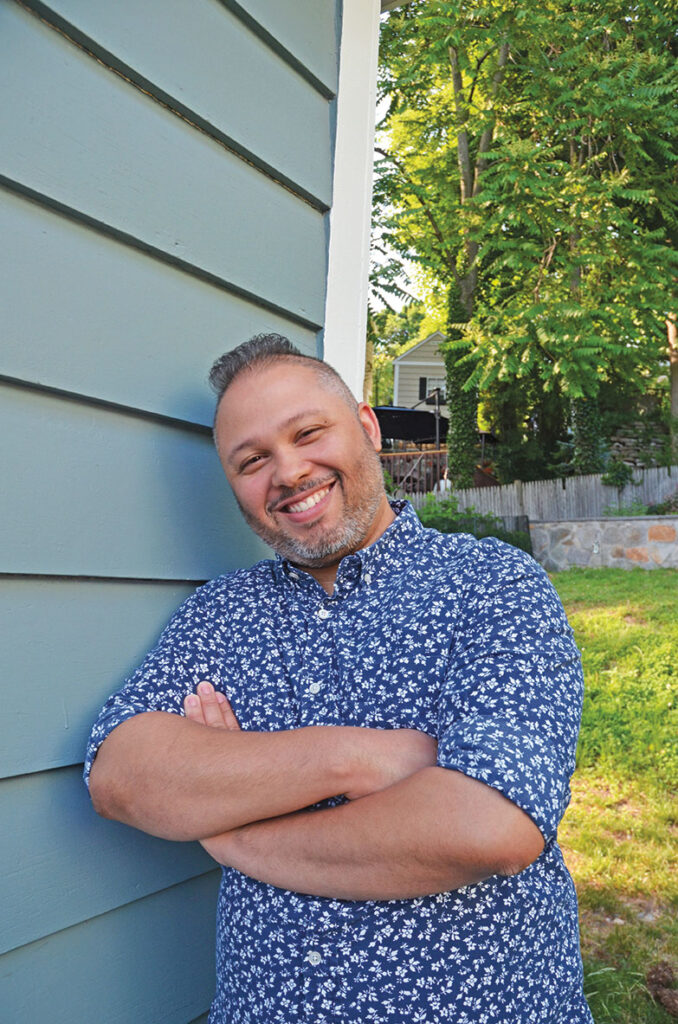 DEGREES: B.A. in political science; M.A. in design and entrepreneurship, School of Visual Arts
DEGREES: B.A. in political science; M.A. in design and entrepreneurship, School of Visual Arts
JOB TITLE: Design director, City of Boston; founder, co-owner, and chief creative officer, Nahi
FAVORITE TRINITY MEMORY: I have so many, it’s almost impossible to pick. Great long talks at Cleo [literary society]. I remember getting some Cuban cigars and smoking them on the hill by the Chapel with my friends Roberto Santamaria and Joe Stramondo. I watched Shaun of the Dead over and over with friends. And my first kiss with my wife!
What led to your interest in design? It was actually working for the Trinity College Activities Council! I was making ads and collateral for events because I knew a little bit of Photoshop. At one point, I helped a friend’s roommate make posters for his student government campaign, and I realized I could help make real change that way. I majored in political science because I was interested in running for office, but design was a different way to help people.
What do you do in your role with the City of Boston? My team and I work with 75-plus departments, programs, and initiatives that serve the City of Boston. Our job is to help them with their external communications and outreach to help our citizens with services. That includes everything from the city’s website to billboard ads about how to stay safe during COVID-19. We conduct user testing to make sure what we are creating is actually useful to the public. And many things we develop go out in up to 10 languages.
Has your work changed with the COVID-19 pandemic? One of the last projects I worked on before COVID-19 included outreach materials about how to revive someone from a drug overdose with Narcan, and I shared it on social media and commented that sometimes I wish people didn’t have to use the things I create. COVID-19 has been like a master class in that statement. We are still doing the same work that we always did, but it has pivoted to a singular topic. Messaging is constantly changing as we learn more about how to fight the virus and how people are keeping themselves safe. We are trying new methods to reach people and to connect with them at a time when we as a society can feel disconnected. In our messaging, sometimes we need to be factual, sometimes we need to be warm, sometimes we need to be official. Our singular goal is to keep people safe and to keep infection rates down through communications.
Why did you found your own firm? Nahi, meaning “we” in Apache, is a design firm I co-founded with my partner, Reilly (Zlab) Martin. We founded Nahi because we saw that there was a great need for nonprofits, small businesses, educational institutions, and governments to have good design at a price they could afford. We know how expensive it is to hire a designer—and not everybody can afford it. So we created a revolutionary “pay what you can afford” model. The idea is that our client comes to us with whatever they can afford, and we create what they need within their budget. We also take on three pro bono projects per year. It allows us to demonstrate the value of design, do good in the world, and support our communities. Because we are a woman- and minority-owned small business, we often get clients who are interested in different perspectives.
What do you enjoy most about your work in design? Translating my talents into a way to actually help my communities and the people I care about. When designing something, it has to have purpose and be of use. I think one of the greatest things a person can do in their life is be of use to their communities. I’m a member of the Choctaw-Apache Tribe of Ebarb. On the day I received my adult name, my tribal shaman tasked me with speaking for my people. It is part of my purpose in life, and I feel like design helps me achieve that.
How did your time at Trinity prepare you for what you do now? As you can imagine, my job can be political! A degree in political science and an understanding of how government works comes in handy. After graduating, I was able to get a fifth-year art fellowship at Trinity, which helped me develop my portfolio so that I could then apply to graduate school. At Trinity, I formed lifelong friendships and met my wife, and those relationships are a big support in my life.
What was the most memorable course you took at Trinity? “Design I” set me on the path I’m currently on. It taught me about form and function and to think about space in new and interesting ways.
Was there a professor at Trinity who was particularly influential? Three professors were extremely influential in my life. Sonia Cardenas made sure that I always pushed for what I believed in and was extremely understanding about my dyslexia. Fred Pfeil taught me how to critique the world and look through different lenses. Pablo Delano, with whom I never took a class, viewed my thesis and introduced me to several artists’ books that changed my life.
